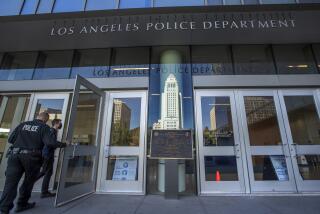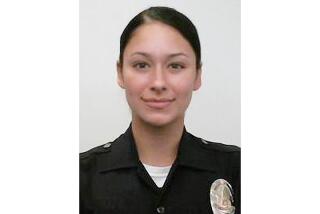Officer Is Cleared in Slaying of Stick Wielder : Shooting: District attorney’s report also offers mild criticism of use of deadly force in 1990 incident.
San Diego Police Officer Charles M. Rice Jr. was cleared Wednesday in last year’s fatal shooting of a University City man who police said attacked four officers with a wooden stake.
An investigation by Dist. Atty. Edwin Miller’s office concluded that Rice, who has been on the police force for five years, was legally justified in using deadly force against William Slusar.
Although he ruled the shooting legal, Miller said the decision to clear Rice did not imply “an endorsement of the actions of the officer involved.” A nine-page investigative report released by Miller also offered mild criticism of police for resorting to deadly force in order to subdue Slusar.
“It seems exceedingly unfortunate that four officers were unable to disarm a man wielding a stick,” the report says.
According to the police report of the incident, Slusar, 39, and weighing 223 pounds, was waving a stake around like a martial arts expert. The stake was described as 33 inches long and three-quarters of an inch thick. Police said the officers who attempted to arrest Slusar feared they would be killed or seriously injured by the stake.
However, Miller’s report suggests that police should have been able to subdue Slusar “regardless of his size or martial-arts skills, without having to resort to deadly force.”
Slusar’s father, Wasil Slusar, called 911 at 12:16 a.m. on Sept. 11 requesting paramedic assistance for his son, who was under the influence of amphetamines. Wasil Slusar told the emergency operator that William Slusar was “real bad off on drugs. . . . He just got violent.”
Before police arrived, William Slusar hit his 65-year-old father on the forehead with a stick, causing three cuts that required 23 stitches to close. Police said they did not know whether Slusar assaulted his father with the same stick he used to threaten the officers.
The district attorney’s report notes that two of the four officers attacked by Slusar drew their weapons, but that Rice, who arrived at the scene as a backup, was the only officer who fired. He shot three rounds from a 9-millimeter automatic pistol, hitting Slusar twice in the upper chest. Slusar died at the scene.
Police described Slusar as ranting and raving, confrontational and urging police to shoot him when they found him in the garage of his parents’ home in the 5800 block of Scripps Street. Slusar moved toward the officers and pulled up a mahogany stake that was stuck in the ground, causing the officers to retreat to the street, police said.
At one point, Slusar approached to within 5 or 6 feet of Rice and raised the stake over his head with both hands, the police report says. Rice told investigators that Slusar “appeared to be looking directly” at him.
“I knew I was within striking distance (of the stake). I couldn’t back up any farther because right behind me was the paramedics and Fire Department personnel,” Rice told investigators. “When he put the stake over his head and started lunging toward me, I thought he was trying to hit me.”
It was the second shooting Rice had been involved in and the second time he was cleared by Miller for using deadly force. On July 6, 1989, Rice shot and wounded Noel Gonzalez, who police said was threatening Rice with a knife.
Officers Rodolfo Reyes and Jeffrey Chione, the first officers to respond to Wasil Slusar’s 911 call, told district attorney investigators that they too would have used deadly force if William Slusar had attacked them with the stake. Other paramedics and firefighters at the scene also backed Rice’s use of deadly force.
But Police Agent Michael Gulyas, who was also at the scene, told investigators he did not think deadly force was necessary to subdue Slusar.
“Agent Gulyas stated that he did not feel it was a life-threatening situation and thought that he might be able to disarm Slusar using his nunchakus,” Miller’s report says, referring to a pair of martial arts weapons.
The report also notes that Gulyas did not attempt to use his nunchakus before Rice fired. Reyes pulled his nunchakus when he first confronted Slusar, but drew his service weapon at the same time as Rice. However, Reyes did not fire.
Firefighter Steve Powers also thought it was unnecessary to shoot Slusar.
“I realize that the stick could have put an eye out, but I didn’t think it was necessary to shoot him,” Powers told investigators.
On Wednesday, an angry Wasil Slusar said, “What else did you expect from the district attorney” when told that Miller had cleared Rice. He refused to comment further.
William Slusar’s mother, Paulette, told The Times after the shooting that police had no reason to shoot her son.
“I was standing right there when they shot him. I said, ‘Don’t!’ but hell, they just shot him anyway,” she said in an interview last year.
Rice and police administrators could not be reached for comment Wednesday.
Rice’s father, Deputy Police Chief Mike Rice, was assigned by Chief Bob Burgreen in August to conduct a thorough review of the department’s shooting policy after a series of controversial incidents involving police. The elder Rice voluntarily removed himself from the assignment after the Slusar shooting.
Deputy Dist. Atty. Stephen Anear, who supervised the district attorney’s investigation, said his investigators interviewed most witnesses but did not interview Slusar’s parents. Anear said his office made no attempt to interview the parents after they talked to police investigators because the Slusars “had retained counsel.”
District attorney investigators mostly relied on police reports of the shooting in conducting their investigation, Anear said.
Since 1983, Miller has cleared more than 100 officers or deputies involved in shootings that resulted in deaths or injuries of suspects.
The last time his office brought criminal charges against an officer involved in a shooting was in 1983, when former Escondido Officer David DeLange was charged with criminal negligence for shooting a woman taken hostage by a bank robber. DeLange was acquitted in May, 1984.
More to Read
Sign up for Essential California
The most important California stories and recommendations in your inbox every morning.
You may occasionally receive promotional content from the Los Angeles Times.










